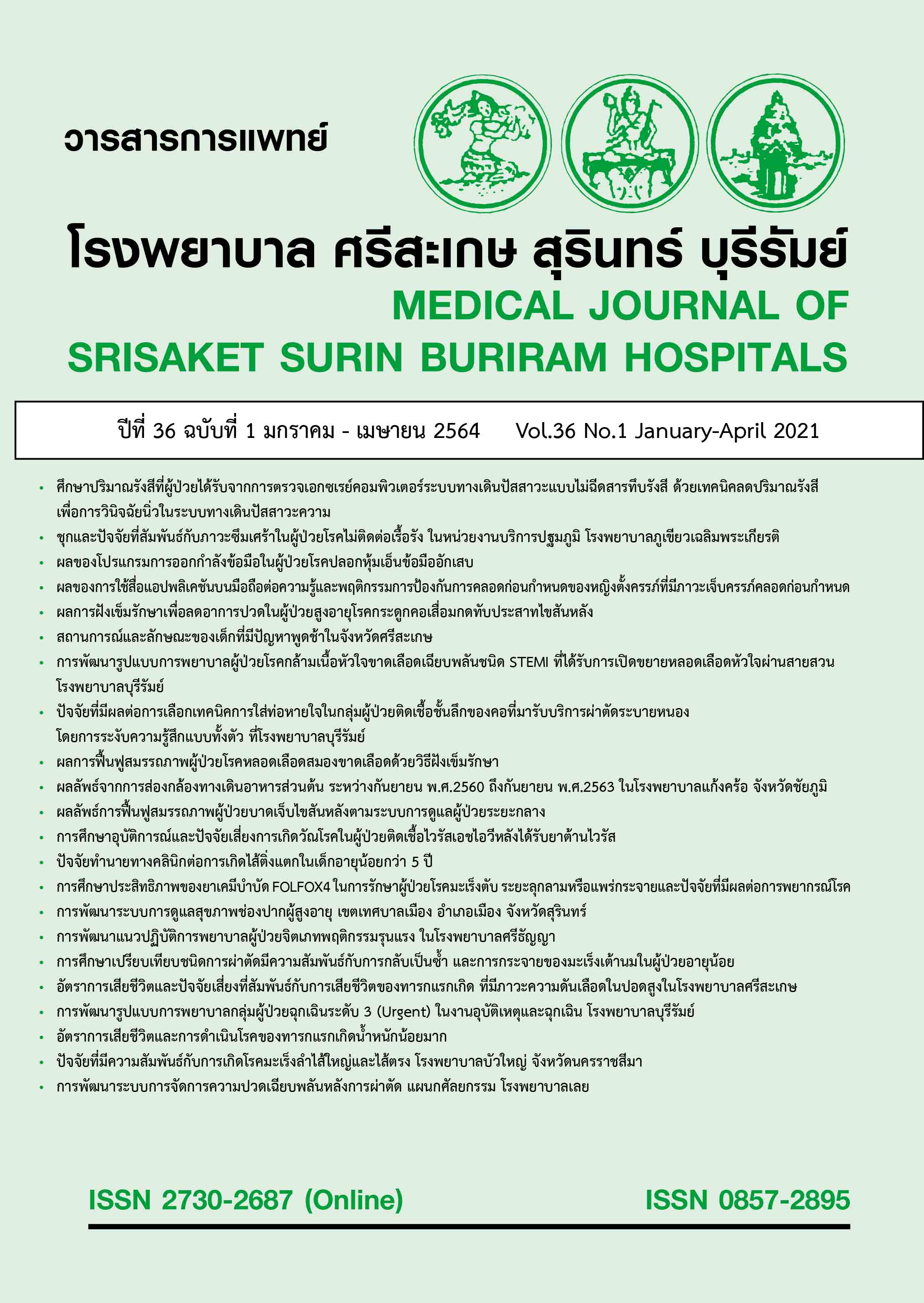ปัจจัยทำนายทางคลินิกต่อการเกิดไส้ติ่งแตกในเด็กอายุน้อยกว่า 5 ปี
Main Article Content
บทคัดย่อ
หลักการและเหตุผล: ไส้ติ่งอักเสบเป็นสาเหตุของการปวดท้องที่ทำให้เด็กต้องได้รับการผ่าตัดช่องท้องฉุกเฉินที่พบบ่อยที่สุดในเด็กอายุน้อยกว่า5ปีพบว่าวินิจฉัยได้ยาก มีโอกาสวินิจฉัยผิดพลาดและมีความเสี่ยงต่อการเกิดไส้ติ่งแตกสูง นำไปสู่การเกิดภาวะแทรกซ้อน
วัตถุประสงค์: เพื่อศึกษาปัจจัยทำนายทางคลินิกที่มีผลต่อการเกิดไส้ติ่งแตกในเด็กอายุน้อยกว่า5 ปี
วิธีการศึกษา: เป็นการศึกษาข้อมูลย้อนหลังในผู้ป่วยเด็กอายุน้อยกว่า 5 ปี ที่ได้รับการวินิจฉัยว่าเป็นไส้ติ่งอักเสบทั้งหมดที่ได้รับการผ่าตัดที่โรงพยาบาลสุรินทร์ ตั้งแต่1 มกราคม พ.ศ.2556 ถึง 31 ธันวาคม พ.ศ.2560 ยืนยันการวินิจฉัยโดยใช้บันทึกการผ่าตัดในเวชระเบียนผู้ป่วยในและผลตรวจชิ้นเนื้อทางพยาธิวิทยาตัวแปรต้น ได้แก่เพศ อายุ น้ำหนัก ระยะเวลาตั้งแต่ปวดท้องจนถึงเวลาที่ได้รับการวินิจฉัย อาการที่พบร่วม อุณหภูมิร่างกาย อัตราการเต้นหัวใจ ความดันโลหิต อาการแสดงทางด้านหน้าท้องจากการตรวจร่างกาย จำนวนเม็ดเลือดขาวทั้งหมด จำนวนเม็ดเลือดขาวชนิดนิวโทรฟิล ผลตรวจปัสสาวะ(จำนวนเม็ดเลือดขาว จำนวนเม็ดเลือดแดงในปัสสาวะ) และระยะเวลาที่ได้รับการวินิจฉัยจนถึงได้รับการผ่าตัด ตัวแปรตาม คือ ภาวะไส้ติ่งแตก วิเคราะห์ผลด้วยการทดสอบ exact probability test, t-test การวิเคราะห์ทีละตัวแปรUnivariatelogistic analysis และการวิเคราะห์การถดถอยโลจิสติกเชิงพหุ (Multivariable logistic regression)
ผลการศึกษา: พบเด็กอายุน้อยกว่า 5 ปี เป็นไส้ติ่งอักเสบที่ได้รับการผ่าตัดและมีการส่งตรวจทางพยาธิวิทยายืนยัน
ทั้งหมด 79 คน พบภาวะไส้ติ่งอักเสบแตกคิดเป็นร้อยละ53.2ส่วนใหญ่เป็นเพศชาย28 คน(ร้อยละ 66.7)จากการศึกษาพบว่าปัจจัยเรื่อง เพศอายุ น้ำหนัก อัตราการเต้นของหัวใจ ความดันโลหิต จำนวนเม็ดเลือดขาวจำนวนเม็ดเลือดขาวชนิดนิวโทรฟิลผลตรวจปัสสาวะที่พบจำนวนเม็ดเลือดขาวและเม็ดเลือดแดงและระยะเวลาที่ได้รับการวินิจฉัยจนถึงได้รับการผ่าตัดไม่สัมพันธ์กับภาวะไส้ติ่งอักเสบแตก ในขณะที่ผู้ป่วยไส้ติ่งอักเสบแตกมีระยะเวลาตั้งแต่ปวดท้องจนถึงเวลาที่ได้รับการวินิจฉัยยาวนานกว่า(61.0± 37.8และ 23.9±19.7 ชั่วโมง, p<0.001) มีอาการที่พบร่วมคือถ่ายเหลวมากกว่า (ร้อยละ 47.6 และ ร้อยละ 21.6 ตามลำดับ, p = 0.020) อุณหภูมิร่างกายสูงกว่า(38.5±1.0°C และ 37.9±0.9°C, p = 0.009) และอาการแสดงทางด้านหน้าท้องจากการตรวจร่างกายในกลุ่มไส้ติ่งอักเสบแตกเป็น generalized tenderness ร้อยละ 57.1 แต่ในกลุ่มไส้ติ่งอักเสบไม่แตกอาการแสดงทางด้านหน้าท้องจากการตรวจร่างกายส่วนใหญ่เป็น Localized tenderness at RLQ ร้อยละ 91.9(p <0.001)จากการวิเคราะห์ Multivariable logistic regression พบปัจจัยทางคลินิกที่มีผลต่อการเกิดไส้ติ่งแตกได้แก่ ระยะเวลาตั้งแต่ปวดท้องจนถึงเวลาที่ได้รับการวินิจฉัยยาวนานกว่า48 ชั่วโมงขึ้นไป มีโอกาสเกิดไส้ติ่งอักเสบแตกเพิ่มขึ้น 7.3 เท่า(95% CI: 1.39 - 38.46) อุณหภูมิร่างกายที่สูงกว่า 38 °C มีโอกาสเกิดไส้ติ่งอักเสบแตกเพิ่มขึ้น 4.4 เท่า (95% CI: 1.31 - 14.89) และอาการแสดงทางด้านหน้าท้องจากการตรวจร่างกายที่มี generalized tenderness มีโอกาสเป็นไส้ติ่งอักเสบแตกเพิ่มขึ้น 8.1 เท่า (95% 1.92- 33.88) โดยมีระดับนัยสำคัญทางสถิติที่ 0.05 (p<0.05)
สรุป: ปัจจัยทำนายทางคลินิกที่มีผลต่อการเกิดไส้ติ่งแตกในเด็กอายุน้อยกว่า5ปีได้แก่ ระยะเวลาตั้งแต่ปวดท้องจนถึงเวลาที่ได้รับการวินิจฉัยยาวนานกว่า48 ชั่วโมงขึ้นไป อุณหภูมิร่างกายที่สูงกว่า 38 °C และอาการแสดงทางด้านหน้าท้องจากการตรวจร่างกายที่มี generalized tenderness
คำสำคัญ: ไส้ติ่่งแตกเด็กอายุน้อยกว่า5 ปี
Article Details
เอกสารอ้างอิง
Addiss DG, Shaffer N, Fowler BS, Tauxe RV. The epidemiology of appendicitis and appendectomy in the United States. American journal of epidemiology 1990;132(5):910-25.
Alloo J, Gerstle T, Shilyansky J, Ein SH. Appendicitis in children less than 3 years of age: a 28-year review. Pediatr Surg Int 2004;19(12):777-9.
Nance ML, Adamson WT, Hedrick HL. Appendicitis in the young child: a continuing diagnostic challenge. Pediatr Emerg Care 2000;16(3):160-2.
Brender JD, Marcuse EK, Koepsell TD, Hatch EI. Childhood appendicitis: factors associated with perforation. Pediatrics 1985;76(2):301-6.
Rothrock SG, Skeoch G, Rush JJ, Johnson NE. Clinical features of misdiagnosed appendicitis in children. Ann Emerg Med. 1991;20(1):45-50.
Vissers RJ, Lennarz WB. Pitfalls in appendicitis. Emerg Med Clin North Am 2010;28(1):103-18.
Horwitz JR, Gursoy M, Jaksic T, Lally KP. Importance of diarrhea as a presenting symptom of appendicitis in very young children. Am J Surg 1997;173(2):80-2.
Seah MD, Ng K-C. Pitfalls in paediatric appendicitis: Highlighting common clinical features of missed cases. Asian J Surg 2006;29(4):262-6.
Samuel M. Pediatric appendicitis score. J Pediatr Surg. 2002;37(6):877-81.
Goldman RD, Carter S, Stephens D, Antoon R, Mounstephen W, Langer JC. Prospective validation of the pediatric appendicitis score. J Pediatr 2008;153(2):278-82.
Ebell MH, Shinholser J. What are the most clinically useful cutoffs for the Alvarado and Pediatric Appendicitis Scores? A systematic review. Ann Emerg Med 2014;64(4):365-72 e2.
van Wijck K, de Jong JR, van Heurn LW, van der Zee DC. Prolonged antibiotic treatment does not prevent intra-abdominal abscesses in perforated appendicitis. World J Surg 2010;34(12):3049-53.
Pogorelic Z, Domjanovic J, Jukic M, Poklepovic Pericic T. Acute Appendicitis in Children Younger than Five Years of Age: Diagnostic Challenge for Pediatric Surgeons. Surg Infect (Larchmt) 2020;21(3):239-45.
Bonadio W, Peloquin P, Brazg J, Scheinbach I, Saunders J, Okpalaji C, et al. Appendicitis in preschool aged children: Regression analysis of factors associated with perforation outcome. J Pediatr Surg. 2015;50(9):1569-73.
Chaiprasit P. Childhood appendicitis in regional hospital. Am Soc Nephrol 2011;32(3).
สถิติหอผู้ป่วยศัลยกรรมเด็ก โรงพยาบาลสุรินทร์. Service Profile งานหอผู้ป่วยศัลยกรรมเด็ก. ศูนย์พัฒนาคุณภาพ โรงพยาบาลสุรินทร์:สุรินทร์; 2559.
Song CW, Kang JW, Kim JY. Different Clinical Features and Lower Scores in Clinical Scoring Systems for Appendicitis in Preschool Children: Comparison with School Age Onset. Pediatr Gastroenterol Hepatol Nutr. 2018;21(1):51-8.
Salo M, Friman G, Stenstrom P, Ohlsson B, Arnbjornsson E. Appendicitis in children: evaluation of the pediatric appendicitis score in younger and older children. Surg Res Pract 2014;2014:438076.
Samelson SL, Reyes HM. Management of perforated appendicitis in children-revisited. Arch of Sur. 1987;122(6):691-6.
Cappendijk V, Hazebroek F. The impact of diagnostic delay on the course of acute appendicitis. Arch Dis Child 2000;83(1):64-6.
Bickell NA, Aufses AH, Jr., Rojas M, Bodian C. How time affects the risk of rupture in appendicitis. J Am Coll Surg 2006;202(3):401-6.
Bröker ME, van Lieshout EM, van der Elst M, Stassen LP, Schepers T. Discriminating between simple and perforated appendicitis. J Sur Res. 2012;176(1):79-83.
Bansal S, Banever GT, Karrer FM, Partrick DA. Appendicitis in children less than 5 years old: influence of age on presentation and outcome. Am J Surg 2012;204(6):1031-5; discussion 5.
Feng W, Zhao XF, Li MM, Cui HL. A clinical prediction model for complicated appendicitis in children younger than five years of age. BMC Pediatr. 2020;20(1):401.
Williams RF, Blakely ML, Fischer PE, Streck CJ, Dassinger MS, Gupta H, et al. Diagnosing ruptured appendicitis preoperatively in pediatric patients. J Am Coll Surg 2009;208(5):819-25; discussion 26-8.
Gosain A, Williams RF, Blakely ML. Distinguishing acute from ruptured appendicitis preoperatively in the pediatric patient. Adv Surg 2010;44:73-85.
Peng Y-S, Lee H-C, Yeung C-Y, Sheu J-C, Wang N-L, Tsai Y-H. Clinical criteria for diagnosing perforated appendix in pediatric patients. Pediatr Emerg Care 2006;22(7):475-9.
Pham XD, Sullins VF, Kim DY, Range B, Kaji AH, de Virgilio CM, et al. Factors predictive of complicated appendicitis in children. J Surg Res 2016;206(1):62-6.
van den Bogaard VA, Euser SM, van der Ploeg T, de Korte N, Sanders DG, de Winter D, et al. Diagnosing perforated appendicitis in pediatric patients: a new model. J Pediatr Surg 2016;51(3):444-8.
Tan PH, Teng XX, Gan ZY, Tan SQ. A Study on the Clinical Factors Associated with Acute Appendicitis and Perforated Appendicitis among Children in a Secondary Medical Centre in Malaysia. Malays J Med Sci 2020;27(4):139-46.


